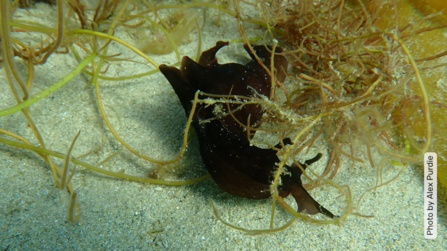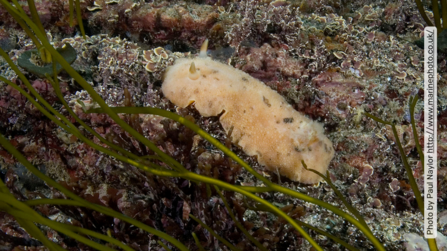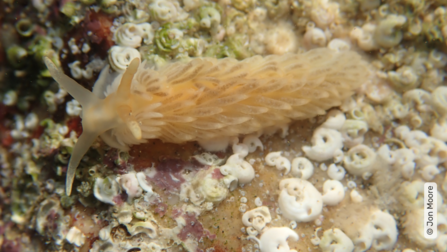Sea slugs come in a wide variety of vibrant colours. In Alderney’s waters, you’re likely to encounter Sea Hare (𝘈𝘱𝘭𝘺𝘴𝘪𝘢 𝘱𝘶𝘯𝘤𝘵𝘢𝘵𝘢) and Sea Lemon (𝘈𝘳𝘤𝘩𝘪𝘥𝘰𝘳𝘪𝘴 𝘱𝘴𝘦𝘺𝘥𝘰𝘢𝘳𝘨𝘶𝘴).
Sea Slug Day - 29/10
Devon Wildlife Trust

Sea Hare, photo by Alex Purdie
Sea Hare’s colour can vary depending on the type of seaweed they eat. Those feeding on mainly sea lettuce are thought to be green while those feeding on red seaweeds can be maroon.

Sea Lemon among thongweed, photo by Paul Naylor
Sea Lemon has its upper side covered in small wart-like bumps and usually bears blotchy markings which can be any combination of yellow, pink, white, brown or green. Sea Lemon grazes on encrusting sponges, chiefly breadcrumb sponge.

A sea slug in the group Aeolida, (C) Jon Moore, photo taken at Clonque
Some sea slugs, like those in the group Aeolida can absorb the stinging cells (nematocysts) from their prey, such as jellyfish and sea anemones, and use them for their own protection.

Orange Clubbed Sea Slug (Limacia clavigera), photo by Lou Collings
Orange Clubbed sea slug is a small white nudibranch with yellow or orange marking on the bumps and finger-like protuberances round its head and down the back of its body. It feeds on encrusting bryozoans such as the sea-mat.
Sea slugs are hermaphrodites, meaning they can reproduce with any other individual.

Sea Lemon and its eggs, photo by Lou Collings
Sea Lemon's egg ribbon is laid in a coil with its bottom edge attached to the substrate. The Sea Lemon's life cycle is completed within a year.

Sea Lemon's egg ribbon, photo by Lou Collings
Sea Lemon's egg ribbon looks like a rosette.
Sea Hares lay eggs in long pink threads, which are deposited on seaweed or rocks and look a bit like pink spaghetti.
Sea slugs can be found in the shallow waters as well as in deep sea. They are slow-moving grazers that consume algae, sponges, sea anemones, jellyfish and other small invertebrates. Sea slugs play a vital role in marine ecosystems by controlling algae and serving as a food source for various animals, including fish, birds, and crabs.


